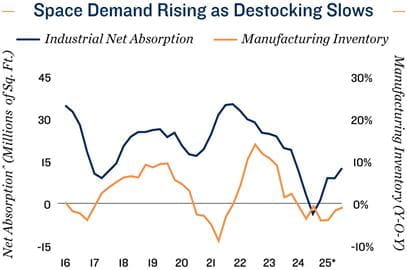Research Brief
Canada Industrial
November 2025

Manufacturing Recovery Continues, Setting Stage for Stronger Industrial Demand
Sales momentum continues to build. Total manufacturing sales rebounded in September, rising 3.3 per cent after a modest decline in August. This monthly gain pushed year-over-year growth back into positive territory, marking the fourth consecutive month of improvement since the measure bottomed in May. The recovery was broad-based across most subsectors and evident in nine provinces. Notably, sales of transportation equipment climbed 9.2 per cent as Ontario-based assembly plants resumed production following summer shutdowns and retooling. In Quebec, sales of aerospace products and parts hit a record high with a 14.9 per cent surge, supported by strong deliveries of business and commercial aircraft and increased production of aerospace engines and parts.
Bank of Canada likely to stay put heading into new year. September’s solid rebound will help rebuild confidence in manufacturing sector, which has faced a series of adverse developments. These range from new U.S. tariffs on trucks and buses to announcements by several firms that they will shift portions of their production south of the border. The strong increase also suggests that Canada’s economy may have grown faster in September than Statistics Canada’s preliminary estimate of 0.1 per cent. This upbeat result adds to the evidence supporting an unchanged policy rate at the BoC’s December meeting. Looking ahead, although forecasters are divided — with some expecting further rate cuts and others anticipating no change through 2026 — monetary policy should remain accommodative, supporting continued momentum in manufacturing.
Space demand recovery expected to broaden but remain uneven. Alongside the decent increase in manufacturing sales, declines in inventory levels are also narrowing. This trend is evident in the industrial sector, where space demand has begun to firm up. Trailing 12-month net absorption continued to improve in the third quarter, fuelled by solid demand gains in Alberta and British Columbia. In contrast, activity in Ontario and Quebec has been slower to regain momentum, reflecting a more gradual and delayed recovery in leasing activity as persistent tariff barriers continue to weigh on tenant sentiment in these more trade-reliant markets. Looking ahead, a more broad-based recovery in space demand is expected to take shape as lower borrowing costs bolster manufacturing activity and businesses adapt to the new trade landscape. However, lingering trade disruptions could remain a key headwind for Ontario and Quebec until Canada-U.S. commercial ties improve meaningfully.
Buyer sentiment returns to larger properties. After concentrating on smaller properties in the first half of the year, investors began shifting towards larger assets — particularly in eastern metros — during the third quarter. Gradually improving space demand likely supported this pickup. At the same time, lower borrowing costs and the region’s strong long-term growth prospects — potentially reinforced by internal trade-liberalization measures in the One Canada Economy Act — also signalled an attractive entry point for capital that had been sitting on the sidelines.


* Through 3Q; ^ Trailing 12-month total
Sources: Marcus & Millichap Research Services; Altus Data Solutions; Statistics Canada
TO READ THE FULL ARTICLE

